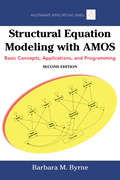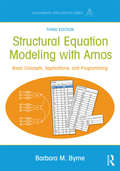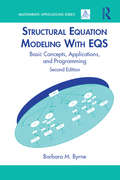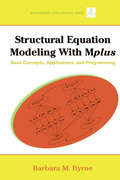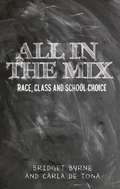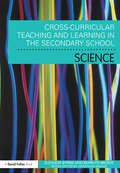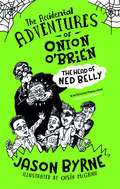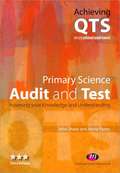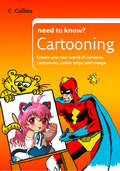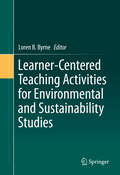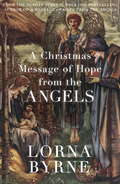- Table View
- List View
A Holy Baptism of Fire and Blood: The Bible and the American Civil War
by James P. ByrdIn his Second Inaugural Address, delivered as the nation was in the throes of the Civil War, Abraham Lincoln proclaimed that both sides "read the same Bible and pray to the same God, and each invokes His aid against the other." He wasn't speaking metaphorically: the Bible was frequently wielded as a weapon in support of both North and South. As James P. Byrd reveals in this insightful narrative, no book was more important to the Civil War than the Bible. From Massachusetts to Mississippi and beyond, the Bible was the nation's most read and respected book. It presented a drama of salvation and damnation, of providence and judgment, of sacred history and sacrifice. When Americans argued over the issues that divided them -- slavery, secession, patriotism, authority, white supremacy, and violence -- the Bible was the book they most often invoked. Soldiers fought the Civil War with Bibles in hand, and both sides called the war just and sacred. In scripture, both Union and Confederate soldiers found inspiration for dying-and for killing-on a scale never before seen in the nation's history. With approximately 750,000 fatalities, the Civil War was the deadliest of the nation's wars, leading many to turn to the Bible not just to fight but to deal with its inevitable trauma. A fascinating overview of religious and military conflict, A Holy Baptism of Fire and Blood draws on an astonishing array of sources to demonstrate the many ways that Americans enlisted the Bible in the nation's bloodiest, and arguably most biblically-saturated conflict.
A Holy Baptism of Fire and Blood: The Bible and the American Civil War
by James P. ByrdIn his Second Inaugural Address, delivered as the nation was in the throes of the Civil War, Abraham Lincoln proclaimed that both sides "read the same Bible and pray to the same God, and each invokes His aid against the other." He wasn't speaking metaphorically: the Bible was frequently wielded as a weapon in support of both North and South. As James P. Byrd reveals in this insightful narrative, no book was more important to the Civil War than the Bible. From Massachusetts to Mississippi and beyond, the Bible was the nation's most read and respected book. It presented a drama of salvation and damnation, of providence and judgment, of sacred history and sacrifice. When Americans argued over the issues that divided them -- slavery, secession, patriotism, authority, white supremacy, and violence -- the Bible was the book they most often invoked. Soldiers fought the Civil War with Bibles in hand, and both sides called the war just and sacred. In scripture, both Union and Confederate soldiers found inspiration for dying-and for killing-on a scale never before seen in the nation's history. With approximately 750,000 fatalities, the Civil War was the deadliest of the nation's wars, leading many to turn to the Bible not just to fight but to deal with its inevitable trauma. A fascinating overview of religious and military conflict, A Holy Baptism of Fire and Blood draws on an astonishing array of sources to demonstrate the many ways that Americans enlisted the Bible in the nation's bloodiest, and arguably most biblically-saturated conflict.
Spirituality in the Workplace: New Directions for Adult and Continuing Education, Number 152 (J-B ACE Single Issue Adult & Continuing Education)
by Marilyn Y. ByrdMissing from the discourse on spirituality are the injustices experienced in the workplace, particularly by individuals marginalized by social group identity or affiliation. This is a critical omission in that spirituality can stimulate reflection, response, healing, and transformation of the soul. Filling the gap by addressing the role of spirituality in relation to meaningful work, this volume extends ideas about teaching and learning about spirituality to workplace settings, including the transformative learning theory. In seeking ways to promote moral and socially responsible workplaces and to establish a new way of thinking, the volume lays down a philosophical framework for spirituality in the workplace as a means of emancipation and social justice, and shows how the workplace can be a fruitful context for social justice education.This is the 152nd volume of the Jossey Bass series New Directions for Adult and Continuing Education. Noted for its depth of coverage, it explores issues of common interest to instructors, administrators, counselors, and policymakers in a broad range of education settings, such as colleges and universities, extension programs, businesses, libraries, and museums.
Spirituality in the Workplace: New Directions for Adult and Continuing Education, Number 152 (J-B ACE Single Issue Adult & Continuing Education)
by Marilyn Y. ByrdMissing from the discourse on spirituality are the injustices experienced in the workplace, particularly by individuals marginalized by social group identity or affiliation. This is a critical omission in that spirituality can stimulate reflection, response, healing, and transformation of the soul. Filling the gap by addressing the role of spirituality in relation to meaningful work, this volume extends ideas about teaching and learning about spirituality to workplace settings, including the transformative learning theory. In seeking ways to promote moral and socially responsible workplaces and to establish a new way of thinking, the volume lays down a philosophical framework for spirituality in the workplace as a means of emancipation and social justice, and shows how the workplace can be a fruitful context for social justice education.This is the 152nd volume of the Jossey Bass series New Directions for Adult and Continuing Education. Noted for its depth of coverage, it explores issues of common interest to instructors, administrators, counselors, and policymakers in a broad range of education settings, such as colleges and universities, extension programs, businesses, libraries, and museums.
Handbook of Elliptic Integrals for Engineers and Scientists (Grundlehren der mathematischen Wissenschaften #67)
by Paul F. Byrd Morris David FriedmanEngineers and physicists are more and more encountering integrations involving nonelementary integrals and higher transcendental functions. Such integrations frequently involve (not always in immediately re cognizable form) elliptic functions and elliptic integrals. The numerous books written on elliptic integrals, while of great value to the student or mathematician, are not especially suitable for the scientist whose primary objective is the ready evaluation of the integrals that occur in his practical problems. As a result, he may entirely avoid problems which lead to elliptic integrals, or is likely to resort to graphical methods or other means of approximation in dealing with all but the simplest of these integrals. It became apparent in the course of my work in theoretical aero dynamics that there was a need for a handbook embodying in convenient form a comprehensive table of elliptic integrals together with auxiliary formulas and numerical tables of values. Feeling that such a book would save the engineer and physicist much valuable time, I prepared the present volume.
Structural Equation Modeling With AMOS: Basic Concepts, Applications, and Programming, Second Edition
by Barbara M. ByrneThis bestselling text provides a practical guide to the basic concepts of structural equation modeling (SEM) and the AMOS program (Versions 17 & 18). The author reviews SEM applications based on actual data taken from her research. Noted for its non-mathematical language, this book is written for the novice SEM user. With each chapter, the author "walks" the reader through all steps involved in testing the SEM model including: an explanation of the issues addressed an illustration of the hypothesized and posthoc models tested AMOS input and output with accompanying interpretation and explanation The function of the AMOS toolbar icons and their related pull-down menus The data and published reference upon which the model was based. With over 50% new material, highlights of the new edition include: All new screen shots featuring Version 17 of the AMOS program All data files now available at www.routledge.com/9780805863734 Application of a multitrait-mulitimethod model, latent growth curve model, and second-order model based on categorical data All applications based on the most commonly used graphical interface The automated multi-group approach to testing for equivalence The book opens with an introduction to the fundamental concepts of SEM and the basics of the AMOS program. The next 3 sections present applications that focus on single-group, multiple-group, and multitrait-mutimethod and latent growth curve models. The book concludes with a discussion about non-normal and missing (incomplete) data and two applications capable of addressing these issues. Intended for researchers, practitioners, and students who use SEM and AMOS in their work, this book is an ideal resource for graduate level courses on SEM taught in departments of psychology, education, business, and other social and health sciences and/or as a supplement in courses on applied statistics, multivariate statistics, statistics II, intermediate or advanced statistics, and/or research design. Appropriate for those with limited or no previous exposure to SEM, a prerequisite of basic statistics through regression analysis is recommended.
Structural Equation Modeling With AMOS: Basic Concepts, Applications, and Programming, Second Edition
by Barbara M. ByrneThis bestselling text provides a practical guide to the basic concepts of structural equation modeling (SEM) and the AMOS program (Versions 17 & 18). The author reviews SEM applications based on actual data taken from her research. Noted for its non-mathematical language, this book is written for the novice SEM user. With each chapter, the author "walks" the reader through all steps involved in testing the SEM model including: an explanation of the issues addressed an illustration of the hypothesized and posthoc models tested AMOS input and output with accompanying interpretation and explanation The function of the AMOS toolbar icons and their related pull-down menus The data and published reference upon which the model was based. With over 50% new material, highlights of the new edition include: All new screen shots featuring Version 17 of the AMOS program All data files now available at www.routledge.com/9780805863734 Application of a multitrait-mulitimethod model, latent growth curve model, and second-order model based on categorical data All applications based on the most commonly used graphical interface The automated multi-group approach to testing for equivalence The book opens with an introduction to the fundamental concepts of SEM and the basics of the AMOS program. The next 3 sections present applications that focus on single-group, multiple-group, and multitrait-mutimethod and latent growth curve models. The book concludes with a discussion about non-normal and missing (incomplete) data and two applications capable of addressing these issues. Intended for researchers, practitioners, and students who use SEM and AMOS in their work, this book is an ideal resource for graduate level courses on SEM taught in departments of psychology, education, business, and other social and health sciences and/or as a supplement in courses on applied statistics, multivariate statistics, statistics II, intermediate or advanced statistics, and/or research design. Appropriate for those with limited or no previous exposure to SEM, a prerequisite of basic statistics through regression analysis is recommended.
Structural Equation Modeling With AMOS: Basic Concepts, Applications, and Programming, Third Edition (Multivariate Applications Series)
by Barbara M. ByrneThis bestselling text provides a practical guide to structural equation modeling (SEM) using the Amos Graphical approach. Using clear, everyday language, the text is ideal for those with little to no exposure to either SEM or Amos. The author reviews SEM applications based on actual data taken from her own research. Each chapter "walks" readers through the steps involved (specification, estimation, evaluation, and post hoc modification) in testing a variety of SEM models. Accompanying each application is: an explanation of the issues addressed and a schematic presentation of hypothesized model structure; Amos? input and output with interpretations; use of the Amos toolbar icons and pull-down menus; and data upon which the model application was based, together with updated references pertinent to the SEM model? tested. Thoroughly updated throughout, the new edition features: All new screen shots featuring Amos Version 23.?? Descriptions and illustrations of Amos’ new Tables View format which enables the specification of a structural model in spreadsheet form.???? Key concepts and/or techniques that introduce each chapter. Alternative approaches to model analyses when enabled by Amos thereby allowing users to determine the method best suited to their data.? Provides analysis of the same model based on continuous and categorical data (Ch. 5) thereby enabling readers to observe two ways of specifying and testing the same model as well as compare results. All applications based on the Amos graphical mode interface accompanied by more "how to" coverage of graphical techniques unique to Amos. More explanation of key procedures and analyses that address questions posed by readers All application data files are available at www.routledge.com/9781138797031. The two introductory chapters in Section 1 review the fundamental concepts of SEM methodology and a general overview of the Amos program. Section 2 provides single-group analyses applications including two first-order confirmatory factor analytic (CFA) models, one second-order CFA model, and one full latent variable model. Section 3 presents multiple-group analyses applications with two rooted in the analysis of covariance structures and one in the analysis of mean and covariance structures. Two models that are increasingly popular with SEM practitioners, construct validity and testing change over time using the latent growth curve, are presented in Section 4. The book concludes with a review of the use of bootstrapping to address non-normal data and a review of missing (or incomplete) data in Section 5. An ideal supplement for graduate level courses in psychology, education, business, and social and health sciences that cover the fundamentals of SEM with a focus on Amos, this practical text continues to be a favorite of both researchers and practitioners. A prerequisite of basic statistics through regression analysis is recommended but no exposure to either SEM or Amos is required.
Structural Equation Modeling With AMOS: Basic Concepts, Applications, and Programming, Third Edition (Multivariate Applications Series)
by Barbara M. ByrneThis bestselling text provides a practical guide to structural equation modeling (SEM) using the Amos Graphical approach. Using clear, everyday language, the text is ideal for those with little to no exposure to either SEM or Amos. The author reviews SEM applications based on actual data taken from her own research. Each chapter "walks" readers through the steps involved (specification, estimation, evaluation, and post hoc modification) in testing a variety of SEM models. Accompanying each application is: an explanation of the issues addressed and a schematic presentation of hypothesized model structure; Amos? input and output with interpretations; use of the Amos toolbar icons and pull-down menus; and data upon which the model application was based, together with updated references pertinent to the SEM model? tested. Thoroughly updated throughout, the new edition features: All new screen shots featuring Amos Version 23.?? Descriptions and illustrations of Amos’ new Tables View format which enables the specification of a structural model in spreadsheet form.???? Key concepts and/or techniques that introduce each chapter. Alternative approaches to model analyses when enabled by Amos thereby allowing users to determine the method best suited to their data.? Provides analysis of the same model based on continuous and categorical data (Ch. 5) thereby enabling readers to observe two ways of specifying and testing the same model as well as compare results. All applications based on the Amos graphical mode interface accompanied by more "how to" coverage of graphical techniques unique to Amos. More explanation of key procedures and analyses that address questions posed by readers All application data files are available at www.routledge.com/9781138797031. The two introductory chapters in Section 1 review the fundamental concepts of SEM methodology and a general overview of the Amos program. Section 2 provides single-group analyses applications including two first-order confirmatory factor analytic (CFA) models, one second-order CFA model, and one full latent variable model. Section 3 presents multiple-group analyses applications with two rooted in the analysis of covariance structures and one in the analysis of mean and covariance structures. Two models that are increasingly popular with SEM practitioners, construct validity and testing change over time using the latent growth curve, are presented in Section 4. The book concludes with a review of the use of bootstrapping to address non-normal data and a review of missing (or incomplete) data in Section 5. An ideal supplement for graduate level courses in psychology, education, business, and social and health sciences that cover the fundamentals of SEM with a focus on Amos, this practical text continues to be a favorite of both researchers and practitioners. A prerequisite of basic statistics through regression analysis is recommended but no exposure to either SEM or Amos is required.
Structural Equation Modeling With EQS: Basic Concepts, Applications, and Programming, Second Edition (Multivariate Applications Series)
by Barbara M. ByrneReaders who want a less mathematical alternative to the EQS manual will find exactly what they're looking for in this practical text. Written specifically for those with little to no knowledge of structural equation modeling (SEM) or EQS, the author's goal is to provide a non-mathematical introduction to the basic concepts of SEM by applying these principles to EQS, Version 6.1. The book clearly demonstrates a wide variety of SEM/EQS applications that include confirmatory factor analytic and full latent variable models. Written in a "user-friendly" style, the author "walks" the reader through the varied steps involved in the process of testing SEM models: model specification and estimation, assessment of model fit, EQS output, and interpretation of findings. Each of the book's applications is accompanied by: a statement of the hypothesis being tested, a schematic representation of the model, explanations of the EQS input and output files, tips on how to use the pull-down menus, and the data file upon which the application is based. The book carefully works through applications starting with relatively simple single group analyses, through to more advanced applications, such as a multi-group, latent growth curve, and multilevel modeling. The new edition features: many new applications that include a latent growth curve model, a multilevel model, a second-order model based on categorical data, a missing data multigroup model based on the EM algorithm, and the testing for latent mean differences related to a higher-order model; a CD enclosed with the book that includes all application data; vignettes illustrating procedural and/or data management tasks; and description of how to build models both interactively using the BUILD-EQ interface and graphically using the EQS Diagrammer.
Structural Equation Modeling With EQS: Basic Concepts, Applications, and Programming, Second Edition (Multivariate Applications Series)
by Barbara M. ByrneReaders who want a less mathematical alternative to the EQS manual will find exactly what they're looking for in this practical text. Written specifically for those with little to no knowledge of structural equation modeling (SEM) or EQS, the author's goal is to provide a non-mathematical introduction to the basic concepts of SEM by applying these principles to EQS, Version 6.1. The book clearly demonstrates a wide variety of SEM/EQS applications that include confirmatory factor analytic and full latent variable models. Written in a "user-friendly" style, the author "walks" the reader through the varied steps involved in the process of testing SEM models: model specification and estimation, assessment of model fit, EQS output, and interpretation of findings. Each of the book's applications is accompanied by: a statement of the hypothesis being tested, a schematic representation of the model, explanations of the EQS input and output files, tips on how to use the pull-down menus, and the data file upon which the application is based. The book carefully works through applications starting with relatively simple single group analyses, through to more advanced applications, such as a multi-group, latent growth curve, and multilevel modeling. The new edition features: many new applications that include a latent growth curve model, a multilevel model, a second-order model based on categorical data, a missing data multigroup model based on the EM algorithm, and the testing for latent mean differences related to a higher-order model; a CD enclosed with the book that includes all application data; vignettes illustrating procedural and/or data management tasks; and description of how to build models both interactively using the BUILD-EQ interface and graphically using the EQS Diagrammer.
Structural Equation Modeling with Mplus: Basic Concepts, Applications, and Programming
by Barbara M. ByrneModeled after Barbara Byrne’s other best-selling structural equation modeling (SEM) books, this practical guide reviews the basic concepts and applications of SEM using Mplus Versions 5 & 6. The author reviews SEM applications based on actual data taken from her own research. Using non-mathematical language, it is written for the novice SEM user. With each application chapter, the author "walks" the reader through all steps involved in testing the SEM model including: an explanation of the issues addressed illustrated and annotated testing of the hypothesized and post hoc models explanation and interpretation of all Mplus input and output files important caveats pertinent to the SEM application under study a description of the data and reference upon which the model was based the corresponding data and syntax files available at http://www.psypress.com/sem-with-mplus/datasets . The first two chapters introduce the fundamental concepts of SEM and important basics of the Mplus program. The remaining chapters focus on SEM applications and include a variety of SEM models presented within the context of three sections: Single-group analyses, Multiple-group analyses, and other important topics, the latter of which includes the multitrait-multimethod, latent growth curve, and multilevel models. Intended for researchers, practitioners, and students who use SEM and Mplus, this book is an ideal resource for graduate level courses on SEM taught in psychology, education, business, and other social and health sciences and/or as a supplement for courses on applied statistics, multivariate statistics, intermediate or advanced statistics, and/or research design. Appropriate for those with limited exposure to SEM or Mplus, a prerequisite of basic statistics through regression analysis is recommended.
Structural Equation Modeling with Mplus: Basic Concepts, Applications, and Programming
by Barbara M. ByrneModeled after Barbara Byrne’s other best-selling structural equation modeling (SEM) books, this practical guide reviews the basic concepts and applications of SEM using Mplus Versions 5 & 6. The author reviews SEM applications based on actual data taken from her own research. Using non-mathematical language, it is written for the novice SEM user. With each application chapter, the author "walks" the reader through all steps involved in testing the SEM model including: an explanation of the issues addressed illustrated and annotated testing of the hypothesized and post hoc models explanation and interpretation of all Mplus input and output files important caveats pertinent to the SEM application under study a description of the data and reference upon which the model was based the corresponding data and syntax files available at http://www.psypress.com/sem-with-mplus/datasets . The first two chapters introduce the fundamental concepts of SEM and important basics of the Mplus program. The remaining chapters focus on SEM applications and include a variety of SEM models presented within the context of three sections: Single-group analyses, Multiple-group analyses, and other important topics, the latter of which includes the multitrait-multimethod, latent growth curve, and multilevel models. Intended for researchers, practitioners, and students who use SEM and Mplus, this book is an ideal resource for graduate level courses on SEM taught in psychology, education, business, and other social and health sciences and/or as a supplement for courses on applied statistics, multivariate statistics, intermediate or advanced statistics, and/or research design. Appropriate for those with limited exposure to SEM or Mplus, a prerequisite of basic statistics through regression analysis is recommended.
All in the mix: Race, class and school choice
by Bridget Byrne Carla De TonaAll in the mix: Race, class and school choice considers how parents choose secondary schools for their children and makes an important intervention into debates on school choice and education. The book examines how parents talk about race, religion and class in the process of choosing. It also explores how parents’ own racialised and classed positions, as well as their experience of education, can shape the way they approach choosing schools. Based on in-depth interviews with parents from different class and racialised backgrounds in three areas in and around Manchester, the book shows how discussions about school choice are shaped by the places in which the choices are made. It argues that careful consideration of choosing schools opens up a moment to explore the ways in which people imagine themselves, their children and others in social, relational space.
Primary Science Audit and Test
by Dr Jenny Byrne Ms Andri Christodoulou Professor John SharpIf you are a primary trainee, you must demonstrate a knowledge of science to be recommended for QTS. This popular, widely recommended, text helps you audit your knowledge of science and understand what learning you need to pass your course. A rigorous test helps you identify your strengths and weaknesses and can be revisited at key stages in your course as a tool to monitor and evaluate progress. The fourth edition has been updated in line with the new National Curriculum, includes more information on expanding and developing your knowledge of science and is linked to the 2012 Teachers’ Standards.
Primary Science Audit and Test (PDF)
by Dr Jenny Byrne Ms Andri Christodoulou Professor John SharpIf you are a primary trainee, you must demonstrate a knowledge of science to be recommended for QTS. This popular, widely recommended, text helps you audit your knowledge of science and understand what learning you need to pass your course. A rigorous test helps you identify your strengths and weaknesses and can be revisited at key stages in your course as a tool to monitor and evaluate progress. The fourth edition has been updated in line with the new National Curriculum, includes more information on expanding and developing your knowledge of science and is linked to the 2012 Teachers’ Standards.
Cross Curricular Teaching and Learning in the Secondary School… Science
by Eleanor Byrne Marilyn BrodieThis book brings together ongoing debates about personalised learning, creativity and ICT in education, with a cross-curricular focus, and establishes a principled framework for cross-curricular teaching and learning in Science. It identifies a range of key issues and aims to strengthen in-school science practices by introducing ways of teaching rigorous science through, and alongside, other subjects. Drawing on examples and case studies taken from innovative practices in different schools and subject areas, as well as summarising lessons from key pieces of research evidence this book includes: Clear theoretical frameworks for cross-curricular processes of teaching and learning in science An analysis of the use of language, ICT and assessment as key components of a skilful pedagogical practice that affect how teaching is delivered and how pupils learn science in cross-curricular contexts A lively account of theoretical issues blended with engaging stories of current practice Practical tasks and questions for reflective practice This timely textbook is essential reading for all students on Initial Teacher Training courses and PGCE courses as well as practising teachers looking to holistically introduce cross-curricular themes and practices in Science.
Cross Curricular Teaching and Learning in the Secondary School… Science
by Eleanor Byrne Marilyn BrodieThis book brings together ongoing debates about personalised learning, creativity and ICT in education, with a cross-curricular focus, and establishes a principled framework for cross-curricular teaching and learning in Science. It identifies a range of key issues and aims to strengthen in-school science practices by introducing ways of teaching rigorous science through, and alongside, other subjects. Drawing on examples and case studies taken from innovative practices in different schools and subject areas, as well as summarising lessons from key pieces of research evidence this book includes: Clear theoretical frameworks for cross-curricular processes of teaching and learning in science An analysis of the use of language, ICT and assessment as key components of a skilful pedagogical practice that affect how teaching is delivered and how pupils learn science in cross-curricular contexts A lively account of theoretical issues blended with engaging stories of current practice Practical tasks and questions for reflective practice This timely textbook is essential reading for all students on Initial Teacher Training courses and PGCE courses as well as practising teachers looking to holistically introduce cross-curricular themes and practices in Science.
The Accidental Adventures of Onion O'Brien: The Head of Ned Belly (The Accidental Adventures of Onion O'Brien)
by Jason ByrneOnion O’Brien is in trouble – again! This time he and the rest of the Five O’s are trying to stop the destruction of the Valley, the local waste ground where they hang out. But Mayor Ronald Bump has other ideas – he wants to build new apartments, and he sets local guards The Ferg and Judge on the children.As if things weren’t bad enough, there’s a new teacher who’s acting very suspiciously. The Five O’s can find out his secret if they manage to win the school talent contest. There’s only one problem – they are completely talentless.Then there’s the discovery of the head of Ned Belly, and the local legend that claims he had hidden treasure …Will the Five O’s manage to outwit The Ferg and Judge, and Ronald Bump, and the new teacher, and solve the mystery of the head of Ned Belly, and save their precious Valley?
Primary Science Audit and Test (PDF)
by Jenny ByrneIf you are a primary trainee, you must demonstrate a knowledge of science to be recommended for QTS. This popular, widely recommended, text helps you audit your knowledge of science and understand what learning you need to pass your course. A rigorous test helps you identify your strengths and weaknesses and can be revisited at key stages in your course as a tool to monitor and evaluate progress. The fourth edition has been updated in line with the new National Curriculum, includes more information on expanding and developing your knowledge of science and is linked to the 2012 Teachers' Standards.
Primary Science: Audit and Test (PDF)
by Jenny Byrne John SharpThis book supports trainees on primary initial teacher training courses where a secure knowledge and understanding of science is required for the award of Qualified Teacher Status (QTS). A rigorous test enables trainees to identify their strengths and weaknesses in science and this can be revisited in order to monitor and evaluate progress towards QTS.
Cartooning: Create Your Own World Of Cartoons, Caricatures, Comic Strips And Manga (Collins Need to Know?)
by John ByrneThis practical step-by-step guide provides an ideal introduction to the exciting and fun world of cartooning, covering a wide range of cartoons, caricatures, comic strips and manga.
A Parent's Guide to Primary School: How to Get the Best Out of Your Child's Education
by Katy Byrne Harvey McGavinA well-written, compelling, meticulously researched resource for parents everywhere. A wonderfully comprehensive guide for parents providing advice on every aspect of their child's education; from choosing a suitable school, to communicating with teachers, through to dealing with the trauma of homework. Practical and accessible, this book really does tell parents everything they need to know to help their children succeed at school.
Learner-Centered Teaching Activities for Environmental and Sustainability Studies
by Loren B. ByrneLearner-centered teaching is a pedagogical approach that emphasizes the roles of students as participants in and drivers of their own learning. Learner-centered teaching activities go beyond traditional lecturing by helping students construct their own understanding of information, develop skills via hands-on engagement, and encourage personal reflection through metacognitive tasks. In addition, learner-centered classroom approaches may challenge students’ preconceived notions and expand their thinking by confronting them with thought-provoking statements, tasks or scenarios that cause them to pay closer attention and cognitively “see” a topic from new perspectives. Many types of pedagogy fall under the umbrella of learner-centered teaching including laboratory work, group discussions, service and project-based learning, and student-led research, among others. Unfortunately, it is often not possible to use some of these valuable methods in all course situations given constraints of money, space, instructor expertise, class-meeting and instructor preparation time, and the availability of prepared lesson plans and material. Thus, a major challenge for many instructors is how to integrate learner-centered activities widely into their courses. The broad goal of this volume is to help advance environmental education practices that help increase students’ environmental literacy. Having a diverse collection of learner-centered teaching activities is especially useful for helping students develop their environmental literacy because such approaches can help them connect more personally with the material thus increasing the chances for altering the affective and behavioral dimensions of their environmental literacy. This volume differentiates itself from others by providing a unique and diverse collection of classroom activities that can help students develop their knowledge, skills and personal views about many contemporary environmental and sustainability issues.
A Christmas Message of Hope from the Angels: A short ebook collection of inspirational writing for the festive period
by Lorna ByrneFrom the Sunday Times number one bestselling author Lorna Byrne.In this short ebook Lorna, who sees angels with as much clarity as the rest of us see people, tells of the special angels she sees at Christmas. She movingly describes the Christmas angels she has seen since she was a child, dropping balls of light onto each and every home, helping us to reconnect with our memories of Heaven. Lorna tells of the blessing angels who she sees walking down from the sky at this time of the year, moving in a way that no other angel does, and reaching out to touch each one of us. This book will awaken the Christmas spirit within all of us with its message that Christmas is about much more than material things - that Christmas is above all at time for kindness and love. THIS CHRISTMAS THEMED BOOK CONTAINS:*The special Christmas Message of Hope chapter from Lorna Byrne's number one bestselling A Message of Hope from the Angels*A Christmas prayer*An interview with Lorna Byrne



